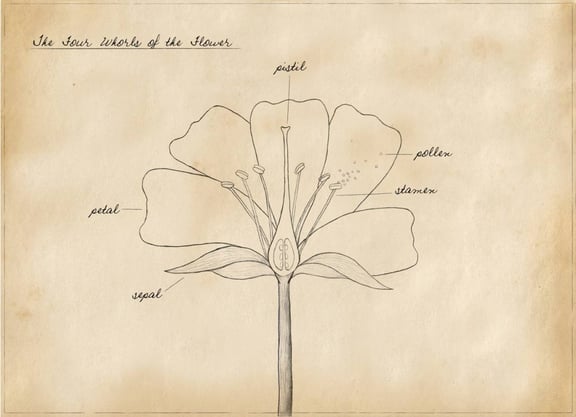Are you excited by the rainbow of little plants springing up and blossoming where you live?
Ever wish you could identify them?
Plant identification is a helpful (and really fun) skill for anyone interested in using plants for food and medicine, as well as for folks who simply enjoy their beauty. The closer you look, the more fascinating they become! A good field guide is always handy, but to fully unlock its usefulness, you need some basic understanding of plant structures.
All month long, I'll be sharing tips, mini-lessons, and my field sketches to help you take a closer look at the lovely flowers all around. You'll learn how to differentiate plant parts, recognize common family characteristics, examine fruits, and add some important terms to your botanical vocabulary. So, with that said, first things first...
The Four Whorls of the Flower
 Click to enlarge
Click to enlarge
In most cases, using a plant's flower will be the best way to reach proper identification. Looking for these four important flower parts and noting their number, shape, and color will help you determine the plant's genus or even the species. While this can sometimes be tricky, the more you practice examining different kinds of flowers, the easier it will be to figure out what's what.
Whorl 1
Calyx - The outermost whorl of the flower made up of sepals. Sepals are often green and enclose the flower bud. They can sometimes be petal-like and showy.
Whorl 2
Corolla - The whorl of petals. Petals are often colorful or showy and range in shape. It's good to note that petals can be totally absent from some species of flowers.
Whorl 3
Stamens - The pollen producing organ of the flower comprised of a stalk called a filament that is topped by an anther.
Whorl 4
Pistil - The innermost organ of a flower consisting of the ovary, style, and stigma. A pollen cell sticks to the stigma, develops a pollen tube and travels down the style to fertilize the ovary which then produces fruit.
You are now ready to become an investigator of inflorescences!
Grab a hand lens or jewelers loupe and prepare for the botanical adventures to begin.
For more in the Basic Botany Series see:
Basic Botany: Sunflower Family
~ Erin











